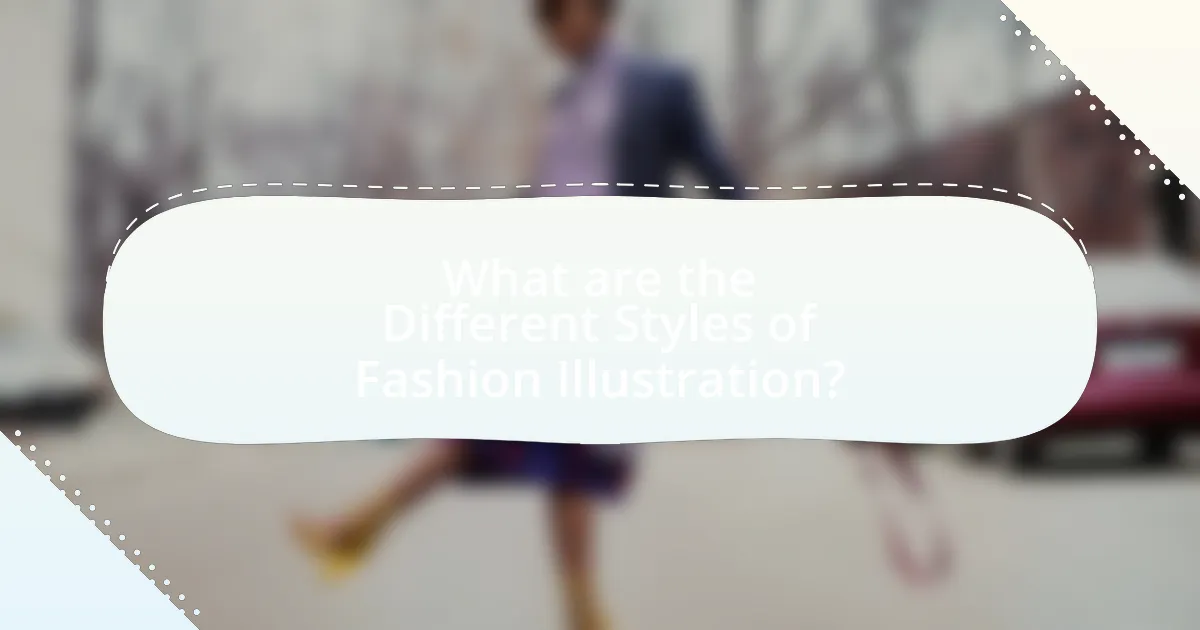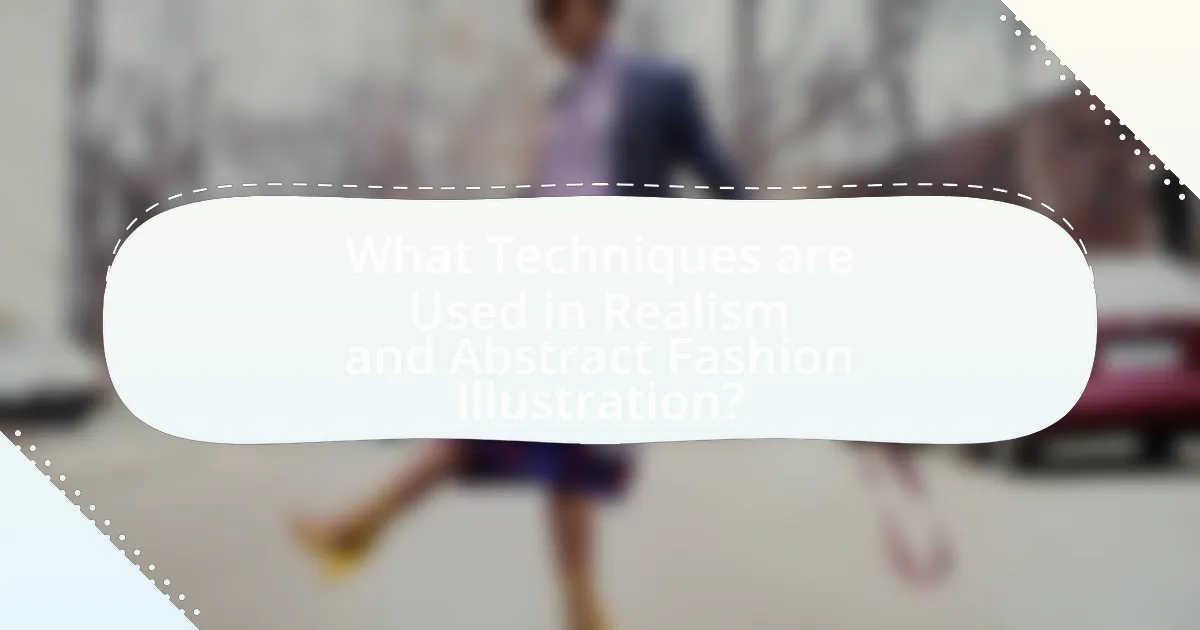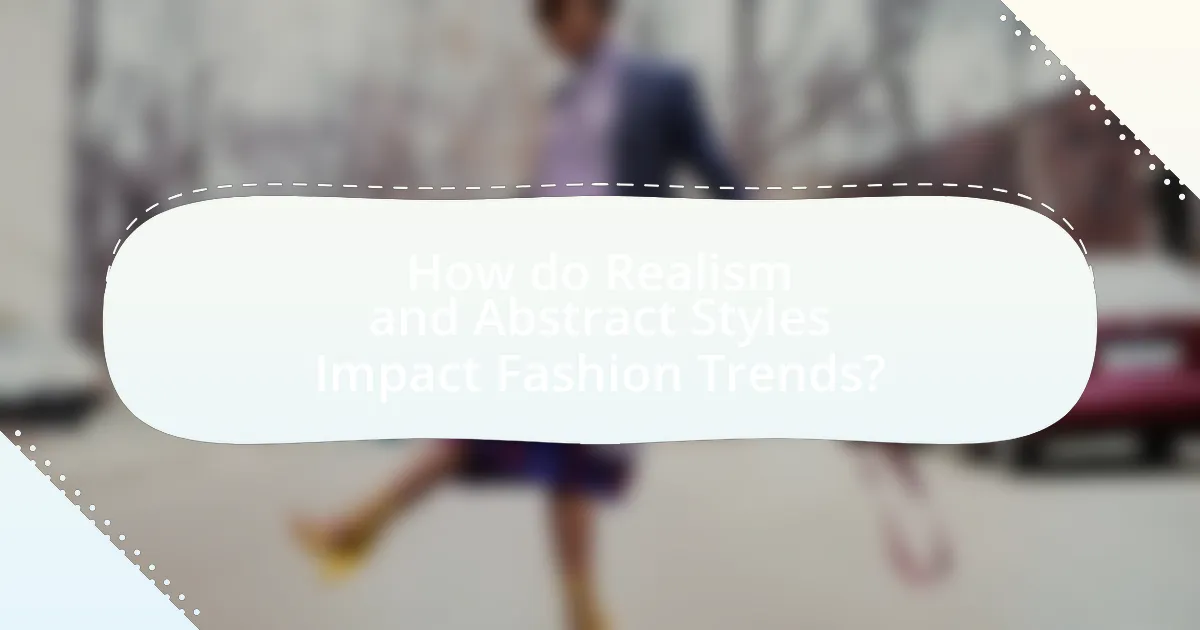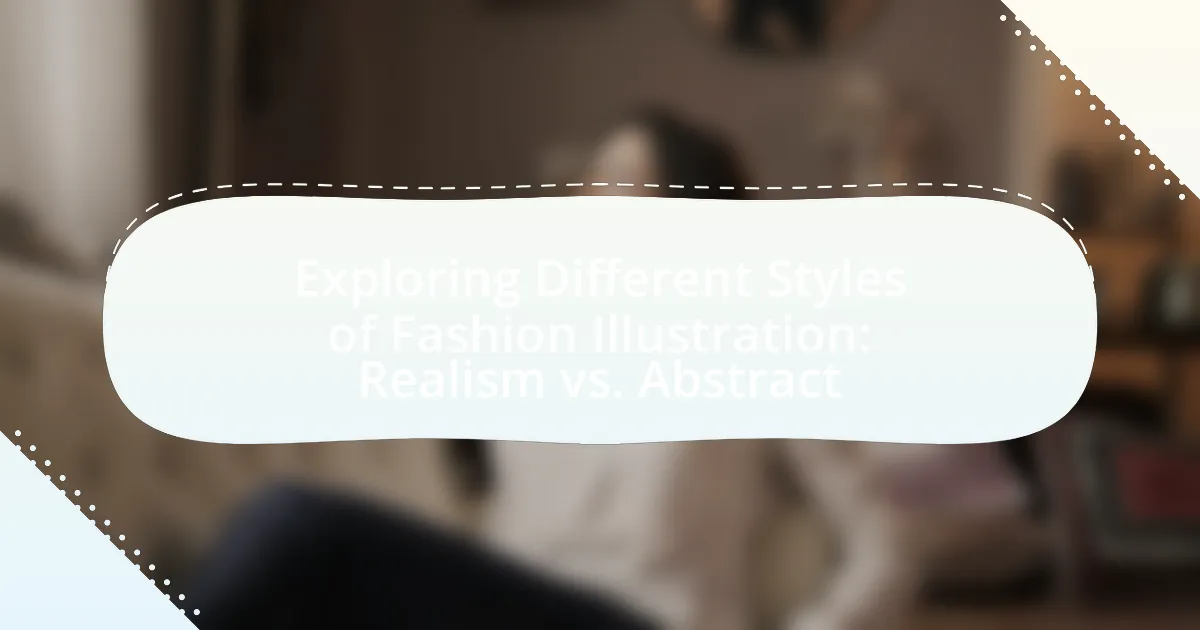The article explores the various styles of fashion illustration, focusing on realism and abstract approaches. It defines realism as an accurate depiction of clothing and figures, emphasizing detail and lifelike representation, while abstract illustration prioritizes creative expression through shapes, colors, and forms. Key characteristics, techniques, and the impact of these styles on fashion trends and marketing are examined, highlighting how they influence consumer perception and designer creativity. Additionally, the article discusses best practices for aspiring illustrators and resources for learning about these distinct styles.

What are the Different Styles of Fashion Illustration?
The different styles of fashion illustration include realism, abstract, minimalism, and caricature. Realism focuses on accurate depictions of clothing and human figures, often using detailed techniques to capture textures and proportions. Abstract fashion illustration emphasizes shapes, colors, and forms over realistic representation, allowing for creative expression and interpretation. Minimalism strips down elements to their essentials, often using simple lines and limited color palettes to convey ideas succinctly. Caricature exaggerates features and proportions for humorous or satirical effect, often highlighting specific traits of the fashion being illustrated. Each style serves distinct purposes in conveying fashion concepts and artistic expression.
How do Realism and Abstract Styles Differ in Fashion Illustration?
Realism and abstract styles in fashion illustration differ primarily in their representation of subjects. Realism aims to depict clothing and figures accurately, focusing on details, proportions, and textures to create lifelike images. In contrast, abstract styles prioritize expression over accuracy, often using exaggerated forms, colors, and shapes to convey emotions or concepts rather than realistic depictions. This distinction is evident in the works of illustrators like David Downton, who exemplifies realism through meticulous detail, while artists like Jean-Paul Goude embrace abstraction, emphasizing bold colors and dynamic forms.
What are the key characteristics of Realism in Fashion Illustration?
The key characteristics of Realism in Fashion Illustration include accurate representation of clothing, attention to detail, and a focus on lifelike proportions and poses. Realism aims to depict fashion as it appears in reality, emphasizing the texture, fabric, and fit of garments. Illustrators often use naturalistic colors and shading techniques to create depth and dimension, making the illustrations appear more three-dimensional. This style contrasts with abstract approaches, which may prioritize artistic expression over realistic depiction. The historical context of Realism in art, particularly during the 19th century, influenced fashion illustration by promoting authenticity and a connection to everyday life.
What defines Abstract Fashion Illustration?
Abstract Fashion Illustration is defined by its emphasis on stylization and abstraction rather than realistic representation. This form of illustration often utilizes exaggerated forms, bold colors, and dynamic lines to convey emotion and movement, prioritizing artistic expression over accurate depictions of clothing or figures. The use of abstraction allows artists to explore concepts and ideas related to fashion, creating a visual language that communicates mood and style in a more interpretive manner. Historical examples include the works of artists like David Downton and Antonio Lopez Garcia, who have significantly influenced the genre by blending traditional techniques with modern aesthetics.
Why are Different Styles Important in Fashion Illustration?
Different styles are important in fashion illustration because they allow for diverse expression and cater to various audiences and purposes. Each style, whether realism or abstract, communicates unique aspects of fashion, influencing how designs are perceived and understood. For instance, realism captures intricate details and textures, making it suitable for high-fashion presentations, while abstract styles can evoke emotions and concepts, appealing to a broader artistic interpretation. This versatility in styles enhances creativity and innovation within the fashion industry, enabling designers to convey their visions effectively and engage different market segments.
How do styles influence the perception of fashion?
Styles significantly influence the perception of fashion by shaping how garments are interpreted and valued within cultural contexts. For instance, realism in fashion illustration often emphasizes accurate representations of clothing, which can enhance the perceived sophistication and wearability of designs, appealing to consumers who prioritize practicality. Conversely, abstract styles may evoke emotional responses and challenge traditional notions of beauty, attracting those who appreciate innovation and artistic expression. Research indicates that visual styles can alter consumer attitudes; a study published in the Journal of Fashion Marketing and Management found that illustrations perceived as more artistic led to higher engagement and interest in the fashion items depicted. Thus, the interplay between style and perception is crucial in determining how fashion is received and understood.
What role does style play in fashion marketing and branding?
Style is a critical component in fashion marketing and branding as it establishes a brand’s identity and differentiates it in a competitive market. A distinct style communicates the brand’s values, target audience, and aesthetic, influencing consumer perception and loyalty. For instance, brands like Chanel and Gucci utilize unique styles that resonate with their heritage and consumer expectations, reinforcing brand recognition and emotional connection. Research indicates that 60% of consumers prefer brands that reflect their personal style, highlighting the importance of aligning marketing strategies with stylistic elements to enhance engagement and sales.

What Techniques are Used in Realism and Abstract Fashion Illustration?
Realism in fashion illustration employs techniques such as detailed observation, accurate proportions, and lifelike rendering to capture the essence of garments and models. Artists often use mediums like pencil, watercolor, or digital tools to achieve high fidelity in textures, colors, and shadows, reflecting real-life appearances. In contrast, abstract fashion illustration utilizes techniques like simplification, exaggeration, and stylization to convey emotions or concepts rather than realistic representations. This style often incorporates bold colors, dynamic lines, and unconventional forms, allowing for creative expression that transcends literal depiction. Both styles serve distinct purposes in the fashion industry, with realism focusing on accuracy and abstraction emphasizing artistic interpretation.
How do artists achieve Realistic Effects in Fashion Illustration?
Artists achieve realistic effects in fashion illustration by employing techniques such as accurate proportions, detailed textures, and effective use of light and shadow. These techniques allow artists to create lifelike representations of garments and figures. For instance, using a grid method helps maintain correct proportions, while layering colors and employing blending techniques can simulate fabric textures. Additionally, artists often study real-life references, including photographs and live models, to capture the subtleties of human anatomy and clothing draping. This practice is supported by the observation that realism in art often relies on meticulous attention to detail and an understanding of visual perception, as noted in studies on artistic techniques.
What materials and tools are commonly used for Realism?
Realism in fashion illustration commonly utilizes materials such as graphite pencils, charcoal, watercolors, acrylics, and oil paints, along with tools like brushes, blending stumps, and fine liners. These materials allow artists to achieve detailed textures and lifelike representations, which are essential characteristics of the Realism style. For instance, graphite pencils provide precision for intricate details, while watercolors and acrylics enable the creation of vibrant colors and subtle gradients, enhancing the realistic portrayal of fabrics and human figures.
What techniques enhance the realism in illustrations?
Techniques that enhance realism in illustrations include the use of accurate proportions, detailed textures, and effective lighting. Accurate proportions ensure that the elements within the illustration are in correct relation to one another, which is essential for creating a believable representation. Detailed textures, such as fabric patterns and skin details, add depth and authenticity, making the illustration more lifelike. Effective lighting techniques, including highlights and shadows, create a three-dimensional effect, enhancing the overall realism. These techniques are supported by studies in visual perception, which indicate that viewers are more likely to perceive an illustration as realistic when these elements are skillfully applied.
What Methods are Employed in Abstract Fashion Illustration?
Abstract fashion illustration employs methods such as simplification, exaggeration, and the use of bold colors and shapes to convey concepts rather than realistic representations. These techniques allow artists to focus on the essence of fashion, emphasizing movement, form, and emotion over detailed accuracy. For instance, artists may use fluid lines and dynamic compositions to evoke a sense of energy and style, as seen in the works of renowned illustrators like David Downton and Antonio Lopez. Their illustrations often prioritize visual impact and artistic expression, demonstrating how abstraction can effectively communicate fashion ideas.
How do color and form contribute to Abstract styles?
Color and form are fundamental elements that shape Abstract styles in fashion illustration. Color evokes emotions and sets the mood, while form provides structure and visual interest. For instance, bold, contrasting colors can create a sense of energy and dynamism, often seen in the works of artists like Wassily Kandinsky, who used color to express feelings rather than represent reality. Similarly, the manipulation of form allows artists to break away from traditional representations, enabling them to explore shapes and lines that convey movement and abstraction, as demonstrated in the works of Pablo Picasso. This interplay between color and form not only defines the aesthetic of Abstract styles but also enhances the viewer’s emotional engagement with the artwork.
What innovative techniques are popular in Abstract Fashion Illustration?
Innovative techniques popular in Abstract Fashion Illustration include digital manipulation, mixed media, and expressive brushwork. Digital manipulation allows artists to create unique textures and effects that enhance the abstract quality of their work, often utilizing software like Adobe Photoshop or Procreate. Mixed media combines traditional materials such as watercolor, ink, and collage with digital elements, resulting in dynamic compositions that challenge conventional representation. Expressive brushwork emphasizes spontaneity and emotion, often leading to bold, gestural forms that convey movement and energy. These techniques reflect a shift towards more experimental and personal expressions in fashion illustration, aligning with contemporary artistic trends.

How do Realism and Abstract Styles Impact Fashion Trends?
Realism and abstract styles significantly impact fashion trends by influencing design aesthetics and consumer perceptions. Realism, characterized by detailed and lifelike representations, often leads to trends that emphasize practicality and wearability, as seen in collections that prioritize functional silhouettes and relatable styles. For example, designers like Ralph Lauren have utilized realistic illustrations to convey a sense of authenticity, which resonates with consumers seeking everyday fashion.
In contrast, abstract styles, which focus on shapes, colors, and forms rather than realistic depictions, inspire trends that embrace creativity and innovation. This can lead to avant-garde designs that challenge conventional fashion norms, as demonstrated by brands like Comme des Garçons, which often incorporate abstract elements to provoke thought and inspire unique personal expression. The interplay between these styles shapes the fashion landscape, as designers and consumers navigate between the familiar and the experimental, ultimately driving the evolution of trends.
What influence do these styles have on current fashion trends?
Realism and abstract styles of fashion illustration significantly influence current fashion trends by shaping visual aesthetics and consumer perceptions. Realism, with its detailed representation of clothing and textures, enhances the appeal of fashion items, making them more relatable and desirable to consumers. This style often informs marketing strategies, as brands utilize realistic illustrations to showcase their products in a lifelike manner, thereby increasing engagement and sales. Conversely, abstract styles introduce innovative concepts and emotional resonance, encouraging designers to experiment with forms and colors that challenge traditional norms. This push for creativity often leads to trendsetting designs that capture public interest, as seen in recent collections that blend artistic expression with wearable fashion. The interplay between these styles fosters a dynamic fashion landscape, where both realism and abstraction coexist, influencing designers and consumers alike.
How do designers incorporate these styles into their collections?
Designers incorporate realism and abstract styles into their collections by using specific techniques that reflect these artistic approaches. For realism, designers often focus on accurate proportions, detailed textures, and lifelike representations of garments, which can be seen in collections that emphasize traditional tailoring and fabric draping. In contrast, abstract styles allow designers to experiment with exaggerated forms, bold colors, and unconventional silhouettes, often resulting in collections that challenge conventional fashion norms. This duality is evident in runway shows where designers like Alexander McQueen and Dior have successfully blended both styles, showcasing garments that range from meticulously crafted pieces to avant-garde creations that push the boundaries of fashion illustration.
What trends have emerged from the popularity of each style?
The popularity of realism in fashion illustration has led to a trend emphasizing hyper-realistic details and textures, which enhances the viewer’s connection to the garments. This trend is supported by the rise of digital tools that allow artists to create intricate designs that mimic real-life fabrics and lighting. Conversely, the popularity of abstract fashion illustration has fostered a trend towards minimalism and expressive forms, encouraging artists to focus on emotion and concept rather than precise representation. This shift is evidenced by the increasing use of bold colors and unconventional shapes, which challenge traditional aesthetics and invite personal interpretation.
What are the best practices for aspiring fashion illustrators?
Aspiring fashion illustrators should focus on developing a strong foundational skill set in drawing and understanding fashion design principles. Mastery of anatomy, proportion, and garment construction is essential, as these elements contribute to creating accurate and appealing illustrations. Additionally, studying various styles, including realism and abstract, allows illustrators to find their unique voice while adapting techniques from established artists.
Engaging in regular practice and seeking constructive feedback from peers or mentors can significantly enhance an illustrator’s growth. Participating in fashion illustration workshops or online courses can provide valuable insights and techniques. Furthermore, building a diverse portfolio that showcases a range of styles and subjects is crucial for attracting potential clients and opportunities in the fashion industry.
Networking with industry professionals and staying updated on fashion trends through magazines and social media platforms can also provide inspiration and context for an illustrator’s work.
How can one develop a unique style in fashion illustration?
To develop a unique style in fashion illustration, an artist should focus on experimenting with various techniques, mediums, and influences. This process involves studying different styles, such as realism and abstract, to identify elements that resonate personally. By combining these influences with individual creativity, artists can create distinctive illustrations that reflect their vision. Historical examples, such as the works of fashion illustrators like David Downton and Megan Hess, demonstrate how personal interpretation of fashion can lead to a recognizable style. Their success illustrates that a unique style often emerges from a blend of inspiration and personal expression.
What resources are available for learning about these styles?
Books, online courses, and workshops are valuable resources for learning about realism and abstract styles in fashion illustration. Notable books include “Fashion Illustration: Inspiration and Technique” by Anna Kiper, which covers various styles, including realism and abstraction. Online platforms like Skillshare and Udemy offer courses specifically focused on fashion illustration techniques, allowing learners to explore both styles in depth. Additionally, workshops conducted by professional illustrators provide hands-on experience and personalized feedback, enhancing the learning process. These resources collectively offer comprehensive insights into the techniques and principles of both realism and abstract fashion illustration.

Leave a Reply